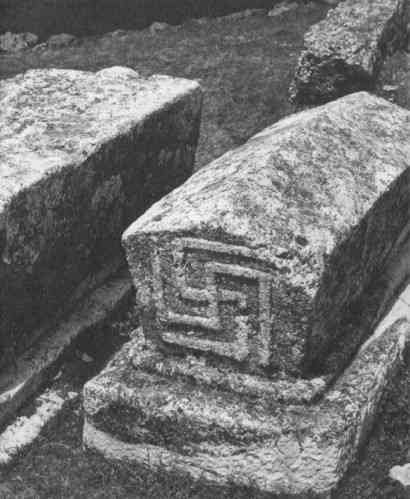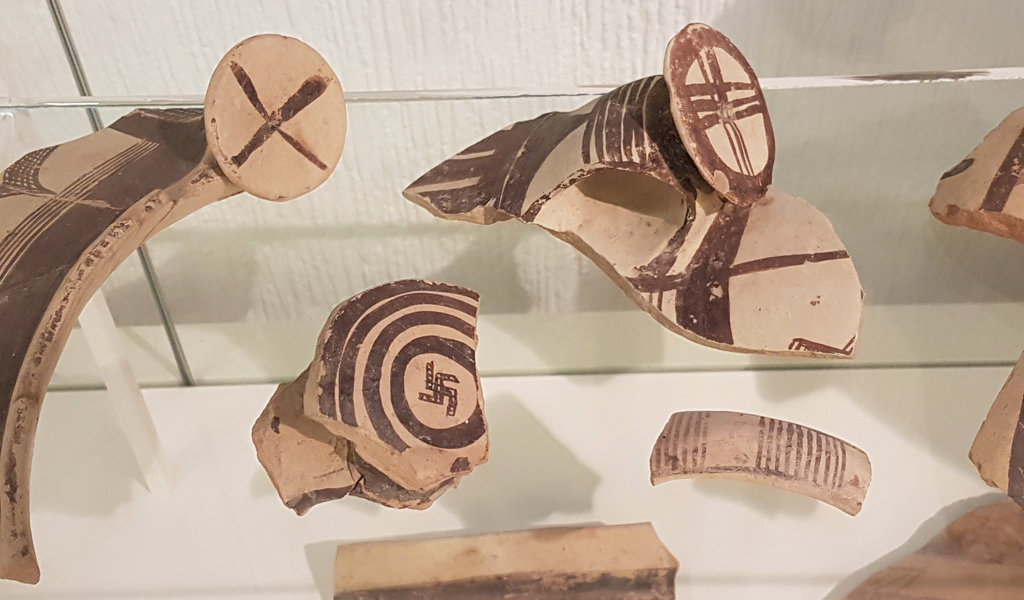First, let me put things in perspective. We have religious symbols of the Abrahamic religions that have been used in wars, aggression, genocide and all kinds of prosecutions – spanning over 2000 plus years. Just reading the Old Testament or the Quran and you’ll find plenty of genocide and hateful mass murder. Now, let’s compare that loaded history with the still fresh one of WWII where the Nazi’s used the Swastika during their 15 years or so of total horror and brutality. As you see, the proportions don’t add up. Why should the Swastika, a symbol used world wide since ancient times be condemn so much in our western culture? Why isn’t the symbolism of the Abrahamic religions free to roam without being offensive? None of them are, as symbols can be used in different contexts and for very different purposes. But let us look at the actual history of the Swastika, where it was first used, what shapes it had and what does it mean today.
In the National Historical Museum of Ukraine in Kiev you can find the oldest known Swastika in the world, dating back to 10 000 plus years. It was found in 1908 in the archeological site of Mezin (located in Mezine). It’s a small figurine of a female bird made from a tusk of a mammoth.

The known earliest use and origin of the Swastika is from Europe and not from India. Although Indians still have it totally more integrated and used compared to Europe due to the history of WWII. Where Hitler used the swastika inspired by an engraving of it in the great abbey church of Lambach where he as a boy attended a catholic monastery school.

The Vinča culture that existed in the area of what is now Bosnia, Croatia and Serbia is the oldest known culture to have actively used the Swastika symbol. But we can imagine that the whole region from Ukraine to the Adriatic did in one way or another use the symbol. In any way, it is to be found all over Europe. Of course, all over the world. Because it is an ancient and sacred symbol.
“Symbols of divine truth were not invented for the amusement of the ignorant; they are the alpha and omega of philosophic thought.” – H. P. Blavatsky
The Swastika comes in some variations but the pattern is typical, no matter the direction. It has been used on Coca Cola bottles, Carlsberg bottles, as sports team dresses, in traditional folk wearing and in every part and aspect of products. Compared to some gourds in western countries today, where the taboo of the symbol has left some are serious groups claiming the symbol and others just being imbecile radical extreme groups on the right wing.
It puts the beautiful symbol in the wrong hands partly, here in Europe and the western world. But in India it’s all free for everyone to use in any way. I do believe we should be free to use it here in Europe again, in product design, dresses, symbols and so on. Why should we spare the Abrahamic symbols who’ve caused 2000 plus years of harm and ignore the Swastika which is much more potent as a symbol? Every symbol and every tool has been misused. Is it in the end just a matter of time? It’s still too fresh of a memory of WWII? But eventually with some time given it’ll gain back it’s acceptance? I don’t know – but for me I wouldn’t excuse or explain anything to anyone if I choose to make use of the Swastika symbolically. That’s why I want to gather up some history and perspectives about it in this post.

It is totally okay for us to feel resonance with ancient symbols and especially those that are close to us ethnically, yet in this symbol we find a global resonance. Which really shows how powerful and wonderful it is. There are different meanings to it, from being the symbol of luck, to represent the divine light, the sun and all those realms on the border of our material and spiritual world. In India with Hinduism, Buddhism, Jainism and in American native tribes and here in Europe with the Slavs, Celts, Greeks and Nordic tribes. We can even find it used in all the Abrahamic religions.
The symbol has many names, like gammadion, fylfot, Zwtiko (meaning ‘life of life’), hakenkreuz and the most famous from Sanskrit swastika. I wonder what it’s original European name was, since it’s (as of today) historically and originally an European symbol. No matter it’s name the swastika is and has been used in all religions, activities and even on branding products, not to mention in everyday design. I believe the symbol will do a comeback because 15 of brutal history cannot bring down a timeless symbol. Even though it’s banned in Germany it isn’t in the EU and Germany tried to get it banned.
It’s still used in Hinduism and Buddhism. The swastika isn’t out for good and never will be. All those who are hysterical about it can first go and have a look at the symbols of global corporations and their dirty work and most important the symbols of countries and religion. The swastika doesn’t belong to any specific country or religion. It’s our to use and relate to in a any way we want or feel right about.
Some links with more info and photos
Mosaics of swastikas
ProSwastika.org
History and meaning of Slavic Swastika – Kolovrat








What do you think?